2019 Ducati Multistrada 950 S Review - First Ride

The capable and versatile Goldilocks of the street-focused Multistrada family
At first blush, the upgrades for the base 2019 Ducati Multistrada 950 were mostly centered around the 6-axis Bosch IMU (Inertial Measurement Unit), translating into better traction control and cornering ABS, but Ducatisti in the United States don’t have the option of buying that plain Jane Multistrada 950. Instead, Americans are forced to enjoy the premium componentry and electronic upgrades of the Multistrada 950 S. Oh how will we ever endure the slings and arrows of Ducati Skyhook Suspension (DSS) continuously adjusting the damping while Ducati Quick Shift (DQS) renders the clutch obsolete after you pull away from a start? After riding the 2019 Ducati Multistrada 950 S for a couple hundred miles of the twistiest Spanish tarmac I’ve had the privilege of sampling, I can answer with certainty that the North American market will get along just fine.
2019 Ducati Multistrada 950 S
| Engine | 18.0/20 |
| Suspension/Handling | 14.0/15 |
| Transmission/Clutch | 8.75/10 |
| Brakes | 9.0/10 |
| Instruments/Controls | 4.5/5 |
| Ergonomics/Comfort | 8.5/10 |
| Appearance/Quality | 9.5/10 |
| Desirability | 9.0/10 |
| Value | 8.5/10 |
| Overall Score | 89.75/100 |
Live With This: 2017 Ducati Multistrada 950 Review
2019 Ducati Multistrada 950 First Look
With a baseline as capable as the 937cc Testastretta 11°, Ducati didn’t really need to change the powerplant much. After all the engine is thoroughly modern, Euro 4-rated for those countries that require it, and delivers a healthy 113 claimed horsepower at 9,000 rpm. Torque fans will like the 71 lb-ft cranked out at 7,750 rpm by the two 94 mm x 67.5 mm cylinders. Two 53 mm cylindrical-section throttle bodies feed the 12.6:1 compression ratio via inputs provided by a Ride-by-Wire throttle. A new self-servo wet slipper clutch, along with its new hydraulic control system, requires less lever effort and prevents rear wheel hop during aggressive downshifts. Also new for 2019 is the the 2-1-2 unit with lateral silencer that tucks away under the optional saddlebags.
With the RbW comes ride modes, and the 950 S has four of them (Sport, Touring, Urban and Enduro). Naturally, each has its own set of engine performance parameters, ABS, and TC settings. While the Sport and Touring modes both offer the full 113 hp Monty, Tour softens the throttle inputs and gives more intrusive ABS and TC settings – though those have the ability to be changed in the custom settings. Urban and Enduro limit the party to just 75 ponies.
Mounted to that 90° V-Twin (or L-Twin for the persnickety among us) and using it as a stressed member, is a trellis frame constructed of thin-walled, large-diameter tubing. According to Ducati, the tubing is “closed off by a rear load-bearing techno-polymer fibreglass element to maximise torsional rigidity.” In the front, an inverted 48mm fork features full adjustability via Ducati Skyhook Suspension. In the back, a DSS shock controls the movement of the new, lighter cast aluminum swingarm. Suspension travel at both ends is a healthy 6.7 in. The 950 S wears a pair of aluminum rimmed wheels with 40 cross-mounted spokes and gravity-cast hubs, allowing for tubeless Pirelli Scorpion Rally tires.
With the Skyhook Suspension, rebound and compression damping settings are constantly tweaked in a semi-active manner that optimizes vehicle balance. The goal is to keep the chassis attitude consistent by continuously monitoring and adjusting the settings to match the road surface. Naturally, the ride modes play a role in the DSS settings, but they can also be adjusted independently to suit the rider’s desires. According to Ducati, the Multistrada 950 S has up to 400 different parameter combinations available to the rider for tuning.
When it comes to braking, the 950 S utilizes a pair of Brembo M4-32 monobloc radial calipers with the number before the dash revealing the number of pistons and the number after the dash referring to the diameter of the pistons. The front discs are 320mm units, and the rear measures 265mm, being gripped by a floating, two-piston caliper. Like the entire Multistrada family, the 950 uses a Bosch IMU to control Bosch Cornering ABS, protecting riders from wheel lock-up even while leaned over. As with the DSS, the settings for the Cornering ABS are linked with the Ride Modes, where the Sport mode receives the least intervention while the Touring and Rain modes ratchet its involvement up. Additionally, the Enduro mode delivers off-road-specific settings like ABS in the front but not in the rear.
Sometimes when attending a new model introduction, the ride feels like it is mostly an exercise in getting to the photo location, taking the photos, and getting back to the hotel. The Multistrada 950 S intro was the polar opposite. In our 200-mile ride, roughly 80% of the roads were winding motorcyclist wet dreams. Yes, we did have a stint on a divided highway, but touring bikes need to be capable of gobbling up the miles. And the 950 S loafed along at an all-day-comfortable cadence with the DSS delivering a magic carpet-like ride on the super slab. Get the S to the mountains, however, and you can awaken the beast.
The smooth tarmac twisted itself into mostly second and third gear corners with the occasional dip into first just for fun. While you can go all racer boy on the Testastretta and charge into and out of the corners screaming in the upper rpm, the mill feels more at home surfing its big torque wave. The engine can even grunt its way out of corners if you let the rpm drop down to 2,000 or so. Just roll on the throttle and listen to the intake noise as it sucks in the atmosphere, burns it up, and spits it out the throaty exhaust. The 937cc displacement means you can hold the throttle wide open a little longer than on the Multi’s bigger brother before you reach “go directly to jail” territory
When it comes to the 950 S’ ride modes, the difference between Sport and Tour were readily apparent as soon as you twist the throttle. Sport has a much more positive response to throttle inputs without being abrupt in the slightest. As someone who values smooth throttle inputs, I found Sport to be the mode I chose in every situation with the exception of riding around town or on the freeway. Although Touring delivers the same ultimate power output, I preferred the snappier response of Sport in most riding situations. Touring does have its place on the 950 S, but it isn’t necessary to mask throttle abruptness, like on some other motorcycles.
The DQS handles up shifts almost seamlessly with the transition between gears melting away in the surge of acceleration. The only time upshifts were balky was when shifting in first gear at low rpm, and why would one use the quickshifter there, anyway? The DQS downshifts weren’t as buttery smooth. First, the gear shift lever required a firm press to initiate the gear change, and you can’t be wishy-washy about it, either – particularly in the second to first gear change or you might end up in neutral. While this only happened to me once, other journalists said they hit neutral a couple of times. That said, being able to clutchlessly change gear up and down allows for more attention to be spent on processing the road ahead – which was essential on the technical roads Ducati found for our ride.
When navigating tight and twisty pavement, a bike’s maneuverability is of primary importance. The Multistrada 950 S does not disappoint. The upright riding position, coupled with the wide handlebar, make it possible to bend the bike into any corner at will. That same leverage allows for easy altering of lines to avoid obstacles in the road or address unexpected decreasing radius corners. The Pirelli Scorpion Trail II tires offer decent grip and no perceptible squirm until you were at about 9/10s pace on the pavement. This is pretty impressive given their semi-dirt intent – too bad our ride was pavement only.
I had the opportunity to ride the 950 S with both cast and spoked wheels, despite the fact that the former are only offered in Europe. Since the cast wheels are a total of 11 lb. lighter than the spoked ones, they are noticeably more responsive. Every steering input requires slightly less effort. The other journalists at the intro were split on preferences with some liking the more planted feel of the spoked tires. I fell in with the group that chose the quicker steering cast wheels, but really it is a matter of personal preference.
Since the DSS is linked to the ride modes, the handling character of the Multi is perceptibly different when choosing Sport or Tour. When in Tour, the suspenders are more forgiving of road irregularities and allow more chassis pitch on serpentine pavement, but it is still possible to get your scoot on in the corners. However, sport riding is much better in Sport mode. The long-travel suspension dives less under braking. Similarly, there is less fore/aft weight shift in the switch from deceleration to acceleration. Both settings do a good job of soaking up bumps before they reach the rider.
I absolutely love the brakes on the Multistrada 950 S. No, they don’t offer the outright stopping power of M50s, but these Brembo M4-32 radial-mount, monoblock calipers are still top-notch for street riding, offering good initial bite and excellent feel no matter the level of braking required. I could comfortably carry my braking all the way to the apex of a corner, knowing what was going on at the front contact patch. If I screwed up, Bosch cornering ABS was there to bail me out – not that I actually tested this out.
Up until now, I’ve focused primarily on the 950 S’ sporting credentials, but it is, by design, a touring bike. Riding position and rider comfort are of primary importance when the days get long. Aside from the high 33.2 in. seat when mounting the bike, the roomy accommodations are quite welcome. The handguards keep the wind off your mitts, lessening the need for using the optional heated grips. The windscreen is one-hand-adjustable at speed and offs a good compromise between cooling air-flow and wind protection. The seat is all day comfortable. The footpegs have rubber inserts to minimize vibration, and a couple of riders said that, with them installed, the brake pedal was hard to operate. I, however, experienced no such issue.
In addition to riding the stock Multistrada 950 S, I had the opportunity to ride it with the $1,400 Touring Pack installed. This accessory package includes the hard bags, heated grips, and a centerstand. Aside from giving me the space to store extra layers of clothing that I no longer needed, the only difference I noticed was the extra mass in the rear of the bike slowed side-to-side transitions a bit. Other than that, the DSS’ preload settings kept the chassis attitude the same. If the Touring Pack isn’t your speed, Ducati offers a Sport Pack, Enduro Pack, and Urban Pack options. The Sport Pack includes a Termignoni slip-on, a billet water pump cover, and LED indicators. The Urban Pack offers a top case, tank pocket bag with Tanklock flange, and USB port, while the Enduro Pack has supplementary LED lights, engine crash bars, an aluminum radiator guard, an aluminum sump guard, and steel footpegs
So, in an epic one-day ride on some of the best winding roads I’ve ever sampled in Spain, the Ducati took what initially looked like a relatively minor update and, with the careful application of some technology to the 2019 Multistrada 950 S, turned it into a stellar sub-1000cc adventure tourer. In fact, if given the option between the Multistrada 950 S and the Multistrada 1260, I would go with the 950 S because of its lighter weight and more streetable power delivery. While people who believe “more is more” will cry heresy, I’m one of those riders who believes that you don’t need the most displacement available to get the most fun and rack up the most miles with a motorcycle.
If you’re in the market for an adventure tourer, you should give the 2019 Ducati Multistrada 950 S a long hard look. It is available in two colors: Ducati Red for $16,995 and Glossy Grey for $17,195.
2019 Ducati Multistrada 950 S
+ Highs
- Fun to ride torque curve
- Skyhook Suspension works great everywhere
- Easy-to-use menu system and bright TFT
– Sighs
- High seat
- Ducati Quick Shift can be balky on downshifts
- Wish the S had a cast wheel option
In Gear
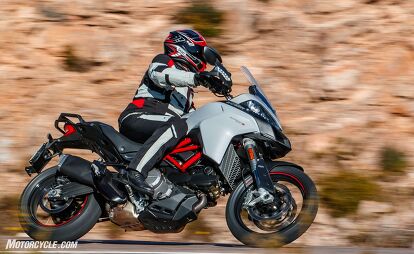
Helmet: Shoei RF-1200, $590
- Jacket: Spidi 4Season H2Out Jacket, $550
- Pants: Spidi 4Season H2Out Pants, $400
- Boots: Alpinestars Supertouring Gore-Tex Boot, $340
Gloves: Reax Castor $89
2019 Ducati Multistrada 950 S Specifications | |
|---|---|
| MSRP | $16,995 (red), $17,195 (grey) |
| Engine Type | 937cc, Testastretta, L-Twin cylinder, Desmodromic timing, Liquid-cooled, DOHC, desmodromic, 4 valves per cylinder |
| Bore and Stroke | 94 x 67.5 mm |
| Compression Ratio | 12.6 : 1 |
| Transmission | 6 speed with Ducati Quick Shift up/down (DQS) |
| Final Drive | Chain |
| Front Suspension | 48 mm fully adjustable usd fork, Electronic compression and rebound damping adjustment with Ducati Skyhook Suspension Evo (DSS) |
| Rear Suspension | Fully adjustable monoshock, Electronic compression, rebound damping and spring pre-load adjustment with Ducati Skyhook Suspension Evo (DSS) |
| Front Brake | Two 320 mm semi-floating discs, Radially mounted Brembo monobloc 4-piston 2-pad calipers, Radial Master Cylinder, Bosch Cornering ABS |
| Rear Brake | 265 mm disc, 2-piston Brembo floating caliper, Bosch Cornering ABS |
| Front Tire | Pirelli Scorpion Trail II 120/70 ZR 19 |
| Rear Tire | Pirelli Scorpion Trail II 170/60 ZR 17 |
| Rake/Trail | 25°/4.2 in. |
| Wheelbase | 62.8 in. |
| Seat Height | 33.1 in., 33.9 in. with high seat accessory, 32.3 in. with low seat |
| Curb Weight (Claimed) | 507 lb. (claimed) |
| Fuel Capacity | 5.3 gal. |
| Colors | Ducati Red, Glossy Grey |

Like most of the best happenings in his life, Evans stumbled into his motojournalism career. While on his way to a planned life in academia, he applied for a job at a motorcycle magazine, thinking he’d get the opportunity to write some freelance articles. Instead, he was offered a full-time job in which he discovered he could actually get paid to ride other people’s motorcycles – and he’s never looked back. Over the 25 years he’s been in the motorcycle industry, Evans has written two books, 101 Sportbike Performance Projects and How to Modify Your Metric Cruiser, and has ridden just about every production motorcycle manufactured. Evans has a deep love of motorcycles and believes they are a force for good in the world.
More by Evans Brasfield



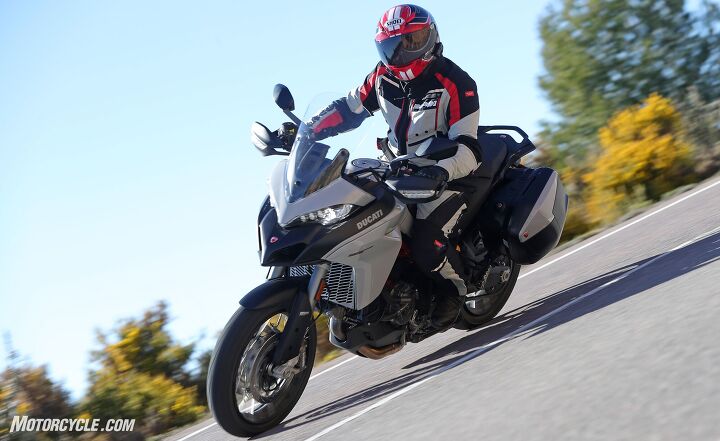





































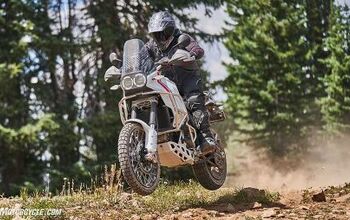


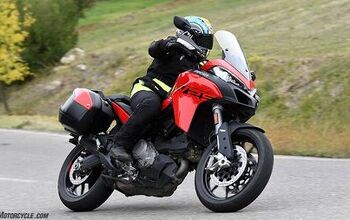
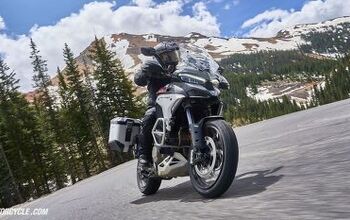
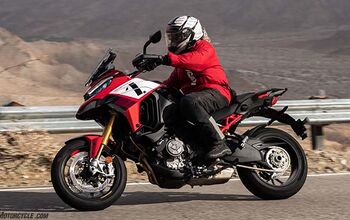
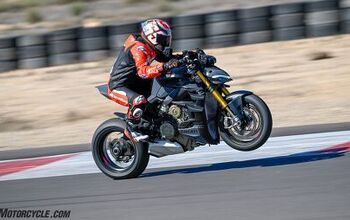










Comments
Join the conversation
I climbed on one of these at a bike shop once. My right leg doesn't work so hot so I always use the left peg as a stirrup when I get on. My foot must have put a little horizontal torque on it as it popped that silly rubber piece right out. I was not a fan of the footpeg on the right one with the rubber either.
Man, this would be an amazing $14k price. At what they're asking though...man, there are some pretty serious options.